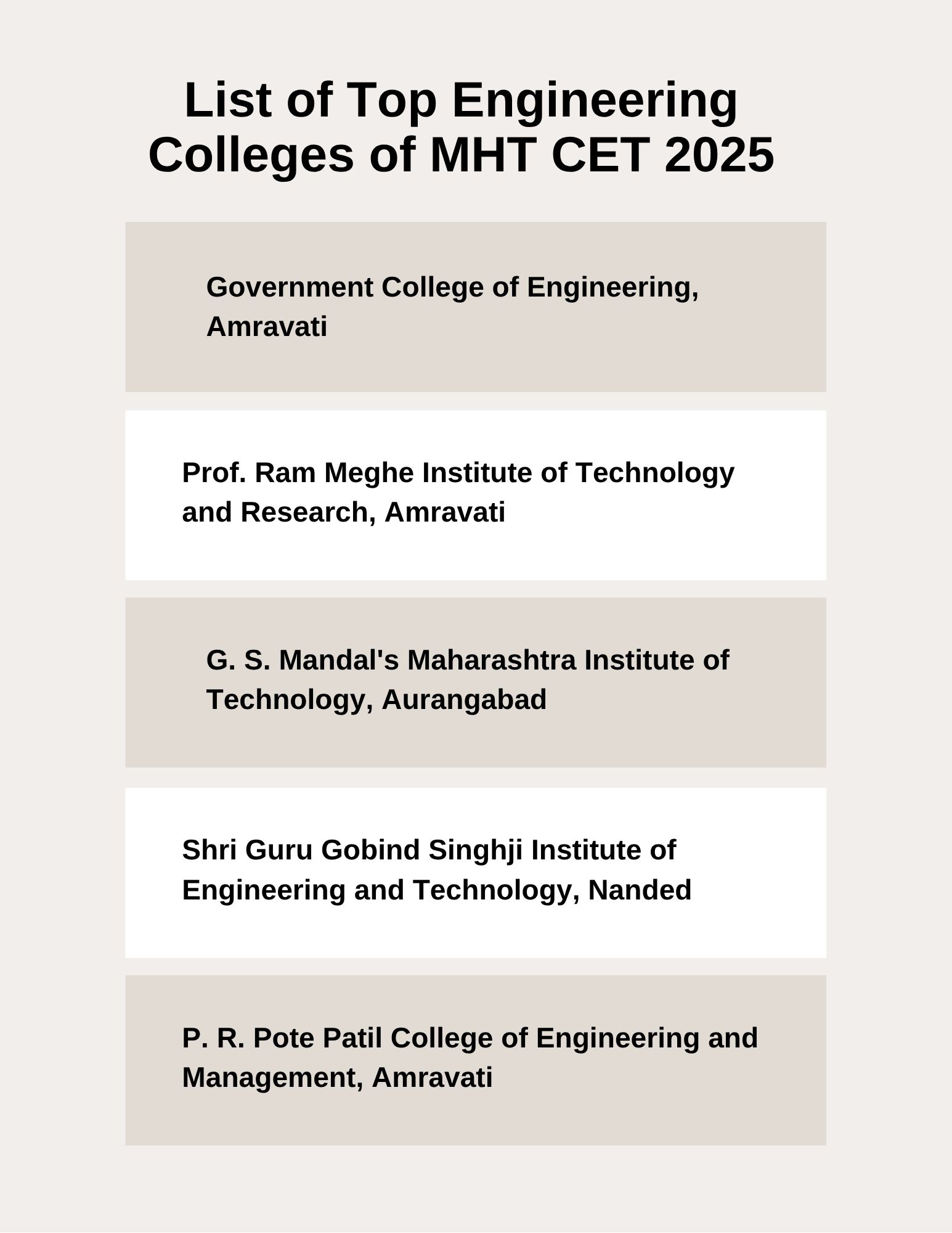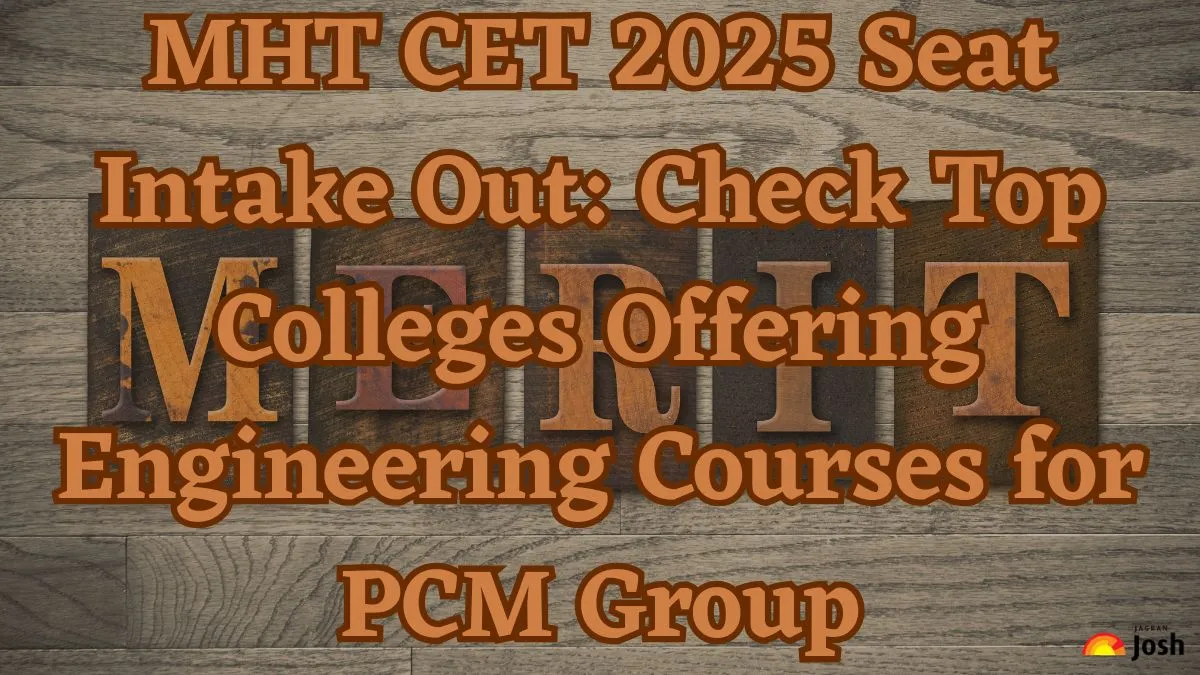The MHT CET 2025 merit list for both PCM (Physics, Chemistry, Mathematics) and PCB( Physics, Chemistry, Biology) streams has been officially announced, marking a major step in the admission process for thousands of students across Maharashtra who appear in the exam. This merit list plays an important role in helping students figure out which colleges they can get based on their ranks and scores.
Whether a candidate you know wants to pursue engineering, pharmacy or health science courses, the merit list gives a clear idea of where you stand in the competition. Understanding how the merit list works, what the cut-offs are for different colleges, and what the closing ranks are to expect can be confusing- especially for first-time applicants.
This article will simplify the entire process. The article will explain how to read the merit list and share the college-wise cutoff marks and ranks for both PCM and PCB groups.
List of Top Engineering Colleges and Their Seat Intake(PCM Group)
If any aspirant is from the PCM group (Physics, Chemistry, Mathematics) and is aiming for top engineering colleges, the aspirant’s rank will decide the aspirant's seat in core branches like Information Technology, Mechanical Engineering, Computer Science or Civil Engineering. Every college has different cutoff ranks based on the popularity of the branch, the number of applicants, and the category reservations.
Below is the list of some of the top engineering colleges and their opening and closing ranks, along with their branches:-
| Colleges | Branches | Seat Intake |
| 60 | ||
| Computer Science and Engineering | 60 | |
| Information Technology | 60 | |
| Electrical Engineering | 60 | |
| Electronics and Telecommunication Engineering | 60 | |
| Instrumentation Engineering | 30 | |
| Mechanical Engineering | 60 | |
| Prof. Ram Meghe Institute of Technology and Research, Amravati | Civil Engineering | 114 |
| 144 | ||
| Information Technology | 144 | |
| Artificial Intelligence (AI) and Data Science | 96 | |
| Mechanical Engineering | 114 | |
| Electronics and Telecommunication Engineering | 96 | |
| Government College of Engineering, Chhatrapati Sambhajinagar | Civil Engineering | 60 |
| 60 | ||
| Computer Science and Engineering | 60 | |
| Electrical Engineering | 60 | |
| Mechanical Engineering | 60 | |
| G. S. Mandal's Maharashtra Institute of Technology, Aurangabad | 30 | |
| Civil Engineering | 120 | |
| Computer Science and Engineering | 306 | |
| Computer Science and Design | 120 | |
| Artificial Intelligence (AI) and Data Science | 114 | |
| Electrical Engineering | 120 | |
| Plastic and Polymer Engineering | 60 | |
| Mechatronics Engineering | 60 | |
| Electronics and Computer Engineering | 120 | |
| Shri Guru Gobind Singhji Institute of Engineering and Technology, Nanded | Civil Engineering | 58 |
| Information Technology | 58 | |
| Computer Science and Engineering | 118 | |
| Electrical Engineering | 28 | |
| 38 | ||
| Chemical Engineering | 28 | |
| Production Engineering | 58 | |
| 28 | ||
| P. R. Pote Patil College of Engineering and Management, Amravati | Civil Engineering | 48 |
| Electrical Engineering | 48 | |
| Computer Science and Engineering | 144 | |
| Electronics and Telecommunication Engineering | 48 | |
| 54 | ||
| 144 | ||
| Artificial Intelligence and Data Science | 144 | |
| Jawaharlal Darda Institute of Engineering and Technology, Yavatmal | Civil Engineering | 60 |
| Computer Science and Engineering | 108 | |
| 60 | ||
| 24 | ||
| Chemical Engineering | 30 | |
| Textile Engineering / Technology | 30 | |
| Deogiri Institute of Engineering and Management Studies, Aurangabad | Civil Engineering | 120 |
| Electronics and Telecommunication Engineering | :114 | |
| Computer Science and Engineering | 96 | |
| Mechanical Engineering | 120 | |
| Veermata Jijabai Technological Institute(VJTI), Matunga, Mumbai | Civil Engineering | 60 |
| Information Technology | 60 | |
| Computer Engineering | 60 | |
| Electrical Engineering | 60 | |
| Electronics Engineering | 60 | |
| Mechanical Engineering | 60 | |
| 60 | ||
| Textile Technology | 60 | |
| 75 | ||
| Dyestuff Technology | 18 | |
| Oil, Oleochemicals and Surfactants Technology | 16 | |
| Pharmaceutical Chemistry and Technology | 18 | |
| Fibres and Textile Processing Technology | 34 | |
| Polymer Engineering and Technology | 16 | |
| 16 | ||
| Surface Coating Technology | 16 |

Also, check:-
MHT CET 2025 Merit Released: What it Means for the Aspirant?
The MHT CET (Maharashtra Common Entrance Test) 2025 merit list has been officially released by the State Common Entrance Test Cell, Maharashtra (https://fe2025.mahacet.org/StaticPages/HomePage). This merit list is prepared separately for the PCM group (Physics, Chemistry, Mathematics) and PCB group (Physics, Chemistry, Biology) streams and helps determine admission eligibility for engineering, health sciences, and pharmacy courses across the state.
The merit list ranks students based on their CET scores and includes details such as the candidate's name, application number, category, and normalised marks. This list plays an important role during the CAP (Centralised Admission Process) rounds, where studentsallocatedotted colleges according to their rank preferences and seat availability.
To make this easier to understand, below is the table for a better understanding:-
| The raw scores obtained by candidates in MHT CET 2025 are normalised to ensure fairness across multiple shifts of the conducted exam, as different exam sessions may have varying levels of difficulty. |
| The normalised score is then converted into a percentile, which is used to create the state-level merit number. |
| Candidates who have submitted their application, verified documents, and met the eligibility criteria are considered in the merit list. |
| Separate merit lists are created for the PCM group (Engineering) and PCB group (Pharmacy and Allied Health Science). |
Also, check:-
- List of Top Participating National Law Universities Through CLAT 2026: Check Other Important Details
What is the Difference between the PCM and PCB Merit list?
The MHT CET merit list is stream-specific, which means the separate lists are released by the Government of Maharashtra and are created for the students based on the subject combination they opted for in the entrance examination. This difference is essential because the syllabus, exam pattern, and the target courses for both groups (PCM and PCB) are different. It ensures that the students are ranked fairly within their respective academic streams and considered for admission to the appropriate set of courses.
The PCM (Physics, Chemistry, Mathematics) group is primarily for students who want to pursue engineering and technology-related courses like the Bachelor of Engineering (B.E.) or the Bachelor of Technology (B.Tech). While the PCB (Physics, Chemistry, Biology) group is intended for those aiming for pharmacy, nursing, and other health science courses, such as B.Pharma or B.Sc. Nursing.
Since the two groups evaluate students based on different subjects and skill sets, the State CET Cell prepares two separate merit lists, one for the PCM group and one for the PCB group, so that the admission process is carried out transparently and efficiently.
Below is the table breaking down the difference between the PCM merit list and the PCB merit list:-
| Criteria | PCM (Engineering) | PCB (Pharmacy and Health Science) |
| Subjects Considered | Physics, Mathematics, and Chemistry | Physics, Chemistry, and Biology |
| Exam Pattern | Questions from PCM Subjects | Questions from PCB Subjects |
| Target Courses | B.E., B.Tech | B.Pharma, D.Pharma, B.Sc. Nursing (For a few select cases) |
| Tie-Breaking | Priority is given to Mathematics marks | Priority is given to Biology marks |
The Maharashtra Common Entrance Test (MHT CET) 2025 merit list and college-wise cutoffs give you a clear picture of where you stand in the admission race. With careful planning, even a mid-range rank can fetch you a seat in a reputed college.
Also, read:-
To stay updated on current trends, join the Jagran Josh Telegram community!
